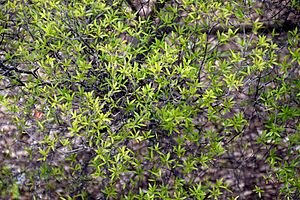Pyrgotis pyramidias facts for kids
Quick facts for kids Pyrgotis pyramidias |
|
|---|---|
| Scientific classification | |
| Kingdom: | |
| Phylum: | |
| Class: | |
| Order: | |
| Family: | |
| Genus: | |
| Species: |
P. pyramidias
|
| Binomial name | |
| Pyrgotis pyramidias Meyrick, 1901
|
|
Pyrgotis pyramidias is a type of moth that belongs to the family Tortricidae. This moth is special because it is only found in New Zealand. Scientists have given it the conservation status of "At Risk, Naturally Uncommon." This means it's not very common in nature.
Interestingly, there seem to be two different kinds, or 'forms', of this moth. Scientists are not entirely sure if these two forms are actually the same species.
Contents
How This Moth Got Its Name
The P. pyramidias moth was first described in 1901. A scientist named Edward Meyrick gave it its name. He studied a moth specimen collected by Alfred Philpott in Invercargill, New Zealand.
Later, in 1928, another scientist named George Hudson wrote about this moth. He also drew pictures of it in his book, The Butterflies and Moths of New Zealand. The original moth specimen Meyrick used to describe the species is kept at the Natural History Museum, London. This original specimen is what scientists call the "holotype."
What This Moth Looks Like
When Edward Meyrick first described P. pyramidias, he noted its features. The male moth was about 16 millimeters (a little over half an inch) long. Its head and chest area were orange. Its front wings were a reddish-orange color. They had dark red spots and some whitish areas. There was also a clear white triangle shape on its back.
The original moth from Invercargill looks a bit plain and is smaller. However, there is another form of this moth. This second form lives in silver beech forests. These moths are usually brighter in color and have more patterns. They are also larger. Because of these differences, some scientists wonder if the larger, more colorful form is truly the same species as the smaller, plainer one.
Where This Moth Lives
This moth is found only in New Zealand. You can find it from the Bay of Plenty area all the way down to Southland.
The smaller, plainer form of the moth lives around places like Awarua Bog and Tiwai Point near Invercargill. It has also been seen in Whakarewarewa in Rotorua. The larger, more colorful form lives in other parts of New Zealand. It is found wherever its favorite food plant grows.
Life Cycle
You can usually see the adult Pyrgotis pyramidias moths flying between October and February. This is when they are active.
What This Moth Eats
The young moths, called larvae or caterpillars, need certain plants to eat. The larvae of the smaller, plainer form of P. pyramidias eat a plant called Leucopogon fasciculatus. This plant is found in the areas where this form lives, like Invercargill and Rotorua.
The larvae of the larger, more colorful form of the moth eat a different plant. They feed on Lophozonia menziesii. This silver beech tree does not grow in the Invercargill area. This is another reason why scientists think these two forms might be different species.
Protecting This Moth
The P. pyramidias moth (the original, smaller form) has a special conservation status. It is listed as "At Risk, Naturally Uncommon" by the New Zealand Threat Classification System. This means that while it's not in immediate danger, it's not very common in nature. It needs to be watched to make sure its population stays healthy.
Images for kids



